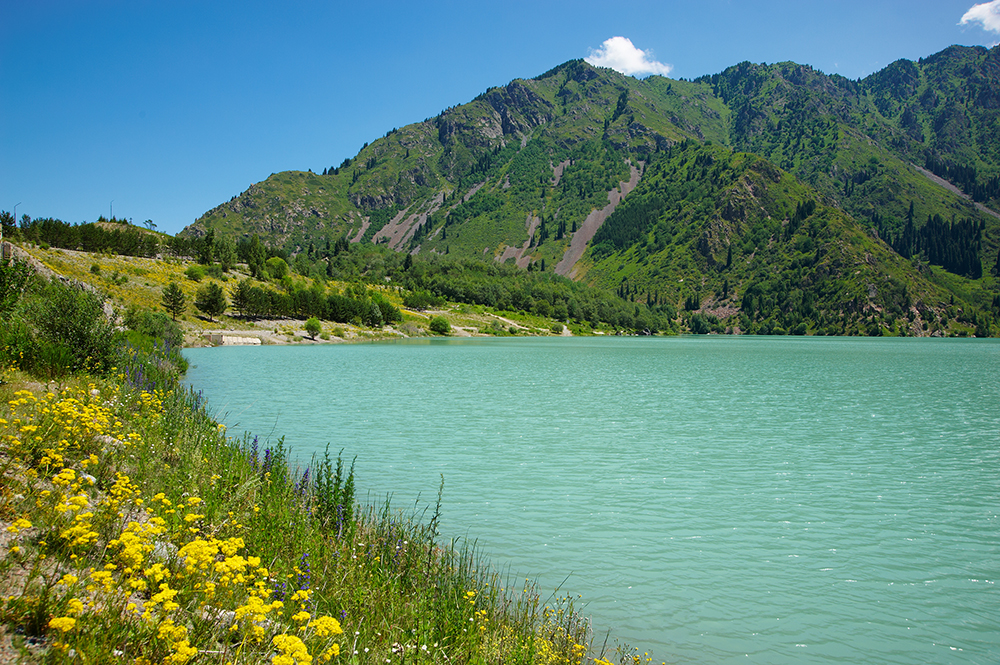For centuries, Kazakhstan was closely tied to the Silk Road and acted as a bridge for the exchange of goods, people, and knowledge between Europe and Asia. Today, it has transformed into an economic hub and, thanks to its oil reserves and precious minerals, it’s the wealthiest of the “Stans” (Afghanistan, Kazakhstan, Kyrgyzstan, Pakistan, Tajikistan, Turkmenistan, and Uzbekistan).
Go beyond the cities, however, and you’ll find scenic mountain ranges, vast steppes, and endless deserts. Here are some essential experiences — both rural and urban — to check out in the region:

The pyramid-shaped Palace of Peace and Accord. Photo courtesy of Ken & Nyetta.
Admire edgy architecture in Astana
Astana has undergone a facelift since it became Kasakhstan’s capital city in 1997. Since then, star architects like Norman Foster and Kisho Kurokawa have designed buildings in the metropolis, helping give Astana its new, ultra-modern look. Some of the most outstanding buildings in the city include the Bayterek Tower, which resembles an egg in a tree, the pyramid-shaped Palace of Peace and Accord, and the Ak Orda presidential palace, which looks like an extraterrestrial corporate HQ.
Watch wildlife at the Aksu-Zhabagly Nature Reserve
Located near the border of Uzbekistan, the Aksu-Zhabagly Nature Reserve covers a massive area of 1,319 km squared (54 sq mi). Established in 1926, the nature reserve is the oldest and most visited in Kazakhstan. It encompasses different types of terrain, ranging from steppes and jailoos (pastures) to juniper forests, high-altitude mountains, and glaciers. Due to efforts by the government to protect this fragile environment, big animals like the ibex, lynx, wolves, bears, and even snow leopards roam this area freely.
Go trekking in the Altai Mountains
Kazakhstan has a number of scenic, challenging treks, but it’s in the Altai Mountains where you’ll find some of the best in the country. Sprawling across the far eastern end of Kazakhstan, the mountain range borders Mongolia, Russia, and China. It’s not easy getting to this remote and sparsely populated region, but its snowy peaks, glaciers, and pristine lakes, make the area worth the journey. Trekkers need to obtain a border-zone permit to go beyond the village of Uryl (Orel), and it’s advisable to hire a porter and horses for the trek.

Pilgrims travel great lengths to visit the Yasaui Mausoleum. Photo courtesy of upyernoz.
Visit the pilgrimage site of Yasaui Mausoleum in Turkistan
The mausoleum of the Sufi master Kozha Akhmed Yasau, is Kazakhstan’s most impressive architectural monument and most important pilgrimage site. Construction on his mausoleum was inaugurated by Timur in the 14th century, and, although it was never completed, it’s still breathtaking in its beauty. Turkistan is now a major centre for Central Asian Sufism, and many pilgrims travel great distances to pay their respects at the site.

Lake Issyk is too cold for swimming — even in summer — but its picturesque beauty makes it worth a visit.
Soak up alpine beauty at Lake Issyk
For a taste of Kazakhstan’s nature that’s a bit closer to Almaty, head to picturesque Lake Issyk, which is surrounded by thick forests and spacious flower fields. Poised at an altitude of 1,760 m (5,774 ft) above sea level, the lake is entrenched within the Issyk gorge of Trans-Ili Alatau. The spearmint-blue water is too cold to swim in even in summer, but it’s a great area for hiking, picnics, and, of course, pictures. The lake was formed 8,000 years ago by a powerful rock avalanche, which later created a natural 300-metre (984 ft) high dam. However, in 1963, the entire lake was emptied and that dam was destroyed by a mudflow that killed more than 100 people. Lake Issyk has since been restored, but is half as large as it was at first.
Dig up history at Mangistau
Bordering neighbouring countries Turkmenistan and Uzbekistan, Mangistau is a far-flung region in southwestern Kazakhstan. The area is home to a stone desert poised on the shores of the Caspian Sea — a harsh and rugged terrain that features a hodgepodge of dramatic canyons, multi-hued rocky outcrops, enigmatic underground mosques, and ancient tombs that are currently being dug out by archaeologists for studies.
Getting there
G Adventures runs a number of trips to Kazakhstan that highlight the Central Asian country's many natural, rural, and urban attractions. We're excited at the prospect of showing you more of this big, blue planet. Check out our small group tours to Kazakhstan here.























